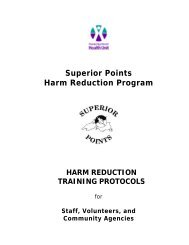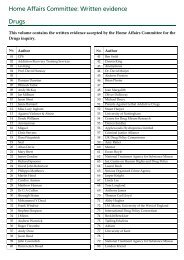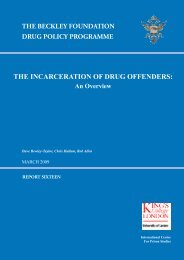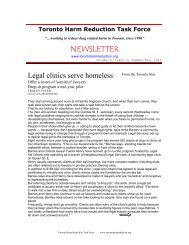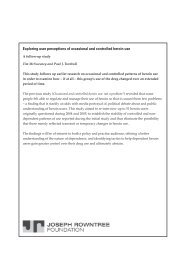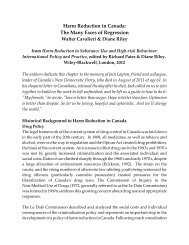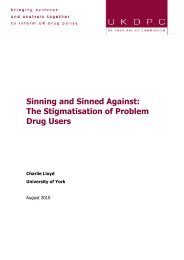A Preliminary Bibliography on Injection Drug Use and Users (IDU) in ...
A Preliminary Bibliography on Injection Drug Use and Users (IDU) in ...
A Preliminary Bibliography on Injection Drug Use and Users (IDU) in ...
Create successful ePaper yourself
Turn your PDF publications into a flip-book with our unique Google optimized e-Paper software.
Klimaforliket Par.cipants: Thomas Beka Geoffrey Guest Daria Mark<strong>in</strong>a Shul<strong>in</strong>g Chen Lillemo Anita Reksten Øyv<strong>in</strong>d Sunde Sortl<strong>and</strong>
ReferencesNati<strong>on</strong>al Task Force <strong>on</strong> HIV, AIDS <strong>and</strong> Injecti<strong>on</strong> <strong>Drug</strong> <strong>Use</strong> HIV, AIDS <strong>and</strong> <strong>in</strong>jecti<strong>on</strong>drug use: a nati<strong>on</strong>al acti<strong>on</strong> plan. 1997. Ottawa, Canadian Public HealthAssociati<strong>on</strong>. This project was funded by the AIDS Preventi<strong>on</strong> & CommunityActi<strong>on</strong> Program under the Nati<strong>on</strong>al AIDS Strategy, <strong>in</strong> collaborati<strong>on</strong> withCanada's <strong>Drug</strong> Strategy, Health CanadaParliamentary Committee Report <strong>on</strong> N<strong>on</strong> Medical <strong>Use</strong> of <strong>Drug</strong>s.http://www.parl.gc.ca/InfoComDoc/37/2/SNUD/Studies/Reports/snudrp01-e.htmAdlaf EM, Zdanowicz YM, Smart RG (1996) Alcohol <strong>and</strong> other drug use am<strong>on</strong>g street<strong>in</strong>volvedyouth <strong>in</strong> Tor<strong>on</strong>to. Addicti<strong>on</strong> Research 4:11-24Altman J . Health Strategy for IV <strong>Drug</strong> <strong>Use</strong>rs <strong>in</strong> the Downtown Eastside. 1998.Vancouver, Vancouver/Richm<strong>on</strong>d Health Board.Anis AHeal (2002) Leav<strong>in</strong>g hospital aga<strong>in</strong>st medical advice am<strong>on</strong>g HIV-positivepatients. CMAJ 167:633-637Archibald C . The Po<strong>in</strong>t Project: A Study of Risk Factors for HIV Infecti<strong>on</strong> Am<strong>on</strong>gVancouver's Injecti<strong>on</strong> <strong>Drug</strong> Us<strong>in</strong>g Community. 1996. Vancouver, B.C.Bardsley J, Turvey J, Blatwick J (1990) Vancouver's Needle Exchange Program.Canadian Journal of Public Health 81:39-45BC Centre for Excellence <strong>in</strong> HIV/AIDS. Project Update: V<strong>IDU</strong>S (Vancouver Injecti<strong>on</strong><strong>Drug</strong> <strong>Use</strong>r Study). Forecast 6[3&4], 6. 1998.Belanger D, et al. Factors expla<strong>in</strong><strong>in</strong>g the <strong>in</strong>tenti<strong>on</strong> to use c<strong>on</strong>doms am<strong>on</strong>g <strong>in</strong>jecti<strong>on</strong> drugusersparticipat<strong>in</strong>g <strong>in</strong> a needle-exchange program. Internati<strong>on</strong>al C<strong>on</strong>ference <strong>on</strong>AIDS (1998).Belanger D, et al. Identificati<strong>on</strong> of sub-groups at high risk of shar<strong>in</strong>g needles am<strong>on</strong>g<strong>in</strong>jecti<strong>on</strong> drug users participat<strong>in</strong>g <strong>in</strong> a needle-exchange program. World AIDSC<strong>on</strong>ference 12th .
Abstract: Objective. To identify who are the drug users shar<strong>in</strong>g <strong>in</strong>jecti<strong>on</strong>material. Methods. In Quebec City, 618 <strong>in</strong>jecti<strong>on</strong> drug users (<strong>IDU</strong>) who used theservices of a needle syr<strong>in</strong>ge exchange program (8.4% HIV+) participated <strong>in</strong> aface-to-face <strong>in</strong>terview. Informati<strong>on</strong> regard<strong>in</strong>g behavioral variables related to thelast 6 m<strong>on</strong>ths as well as sociodemographic variables were obta<strong>in</strong>ed. A logisticregressi<strong>on</strong> analysis was performed <strong>on</strong> two models of shar<strong>in</strong>g needles dur<strong>in</strong>g thelast 6 m<strong>on</strong>ths. The first model compared those shar<strong>in</strong>g <strong>IDU</strong> with those who d<strong>on</strong>ot; the sec<strong>on</strong>d model was based <strong>on</strong>ly <strong>on</strong> shar<strong>in</strong>g <strong>IDU</strong> <strong>and</strong> subdivided them <strong>in</strong> 3groups: those who lended (n=78), borrowed (n=102), or lended <strong>and</strong> borrowed(n=153) <strong>in</strong>jecti<strong>on</strong> material. Results. In the first model, several variables appearedto discrim<strong>in</strong>ate shar<strong>in</strong>g <strong>IDU</strong> from n<strong>on</strong>-shar<strong>in</strong>g <strong>IDU</strong>. These variables were: liv<strong>in</strong>g<strong>in</strong> a shoot<strong>in</strong>g gallery (OR: 4.6, CI95%: 1.5;14.2); the number of hits with the sameneedle syr<strong>in</strong>ge (OR greater than 1 hit: 2.9, CI95%: 1.8;4.6); <strong>in</strong>ject<strong>in</strong>g with anacqua<strong>in</strong>tance (OR: 2.7, CI95%: 1.7;4.2); hero<strong>in</strong> users (OR: 2.2, CI 95%: 1.3;3.5);<strong>in</strong>ject<strong>in</strong>g <strong>in</strong> a shoot<strong>in</strong>g gallery (OR greater than 10 times: 2.1, CI95%: 1.2;3.6); formales, hav<strong>in</strong>g male sexual partners (OR: 2.3, CI95%: 1.3;4.1) <strong>and</strong> age at the<strong>in</strong>terview (OR: 0.97, CI95%: 0.95;0.99). In the sec<strong>on</strong>d model, the discrim<strong>in</strong>at<strong>in</strong>gvariables differed between each logistic equati<strong>on</strong> (<strong>IDU</strong> wholended/borrowed/lended <strong>and</strong> borrowed); <strong>and</strong> also differed from the variable <strong>in</strong>the first model. C<strong>on</strong>clusi<strong>on</strong>. Important variables discrim<strong>in</strong>ate those who sharefrom those who do not share. There is evidence that type of shar<strong>in</strong>g is alsorelated to specific variables.This study was supported by a grant from the Nati<strong>on</strong>al Health Research <strong>and</strong>Development Program, Health Canada.Bruneau J, et al. (1997) High rates of HIV <strong>in</strong>fecti<strong>on</strong> am<strong>on</strong>g <strong>in</strong>jecti<strong>on</strong> drug usersparticipat<strong>in</strong>g <strong>in</strong> needle exchange programs <strong>in</strong> M<strong>on</strong>treal: results of a cohort study.American Journal of Epidemiology 146:994-1002Abstract: The associati<strong>on</strong> between NEP [needle exchange programs] use <strong>and</strong>HIV <strong>in</strong>fecti<strong>on</strong> was exam<strong>in</strong>ed <strong>in</strong> three risk assessment scenarios us<strong>in</strong>g <strong>in</strong>tensivecovariate adjustment for empirical c<strong>on</strong>founders: a cross-secti<strong>on</strong>al analysis of NEPuse at entry as a determ<strong>in</strong>ant of seroprevalence, a cohort analysis of NEP use atentry as a predictor of subsequent seroc<strong>on</strong>versi<strong>on</strong>, <strong>and</strong> a nested case-c<strong>on</strong>trolanalysis of NEP participati<strong>on</strong> dur<strong>in</strong>g follow-up as a predictor of seroc<strong>on</strong>versi<strong>on</strong>.[...] Risk elevati<strong>on</strong>s for HIV <strong>in</strong>fecti<strong>on</strong> associated with NEP attendance weresubstantial <strong>and</strong> c<strong>on</strong>sistent <strong>in</strong> all three risk assessment scenarios <strong>in</strong> our cohort of<strong>in</strong>jecti<strong>on</strong> drug users, despite extensive adjustment for c<strong>on</strong>founders. In summary,<strong>in</strong> M<strong>on</strong>treal, NEP users appear to have higher seroc<strong>on</strong>versi<strong>on</strong> rates than NEPn<strong>on</strong>users. (Author) This research was funded by a grant from the Nati<strong>on</strong>alHealth Research <strong>and</strong>Development Program, Health Canada.
Bruneau J, Franco E, Lamothe F (1997) Assess<strong>in</strong>g harm reducti<strong>on</strong> strategies: thedilemma of observati<strong>on</strong>al studies. American Journal of Epidemiology 146:1007-1010Bulwer P. Safe Injecti<strong>on</strong> Sites: Compell<strong>in</strong>g the Government to Act. 2001. Vancouver,B.C., Pivot Legal Society.Canadian HIV-AIDS Legal Network . <strong>Drug</strong> <strong>Use</strong> & Provisi<strong>on</strong> of Health & Social Services.1999. Ottawa, Canadian HIV-AIDS Legal Network.Canadian HIV-AIDS Legal Network . Injecti<strong>on</strong> <strong>Drug</strong> <strong>Use</strong> <strong>and</strong> HIV/AIDS: EssentialResources - Info Sheet #11. 1999. Ottawa, Canadian HIV-AIDS Legal Network.Canadian HIV/AIDS Legal Network . Injecti<strong>on</strong> <strong>Drug</strong> <strong>Use</strong> <strong>and</strong> HIV/AIDS: The Facts .1999. Ottawa, Canadian HIV-AIDS Legal Network.Abstract: This is <strong>on</strong>e of a series of 12 <strong>in</strong>fo sheets <strong>on</strong> <strong>in</strong>jecti<strong>on</strong> drug use <strong>and</strong>HIV/AIDS: legal <strong>and</strong> ethical issues: 1. Injecti<strong>on</strong> <strong>Drug</strong> <strong>Use</strong> <strong>and</strong> HIV/AIDS: TheFacts (# 9154); 2.The Current Legal Status of <strong>Drug</strong>s (#9156); 3. <strong>Drug</strong> <strong>Use</strong> & Provisi<strong>on</strong> of Health <strong>and</strong> Social Services (# 9158);4.Treatment (# 9160); 5. Prescripti<strong>on</strong> of Opiates & C<strong>on</strong>trolled Stimulants (# 9162);6. <strong>Drug</strong> <strong>Use</strong>rs & Studies of HIV/AIDS & Illegal <strong>Drug</strong>s (# 9164); 7. Informati<strong>on</strong>about the <strong>Use</strong> & Effects of <strong>Drug</strong>s (# 9166); 8. Needle Exchange Programs (# 9168);9. Methad<strong>on</strong>e Ma<strong>in</strong>tenance Treatment (# 9170); 10. Safe Injecti<strong>on</strong> Facilities (#9172); 11. An Obligati<strong>on</strong> to Act (# 9174); 12. Essential Resources (#9176); The<strong>in</strong>formati<strong>on</strong> <strong>in</strong> this series of <strong>in</strong>fo sheets is taken from Injecti<strong>on</strong> <strong>Drug</strong> <strong>Use</strong> <strong>and</strong>HIV/AIDS: Legal <strong>and</strong> Ethical Issues (# 1115), prepared by the CanadianHIV/AIDS Legal Network, but was updated <strong>in</strong> 2002.Caputo T, Weiler W, Anders<strong>on</strong> J . The Street Lifestyle Study. 1997. Ottawa, Office ofAlcohol, <strong>Drug</strong>s <strong>and</strong> Dependency Issues, Health Canada.Daum K . A C<strong>on</strong>t<strong>in</strong>uum of Abuse: Yesterday's Child Sex Abuse Victims are Today'sSexually Exploited Children <strong>and</strong> Tomorrow's Adult Sex Trade Workers. 1997.Vancouver, Downtown Eastside Youth Activities Society.Downtown Eastside Community Crime Preventi<strong>on</strong>/Revitalizati<strong>on</strong> Project . Manag<strong>in</strong>gthe Corner of Ma<strong>in</strong> <strong>and</strong> Hast<strong>in</strong>gs for Health <strong>and</strong> Safety. 1999-2000. Vancouver.Expert Committee <strong>on</strong> AIDS <strong>and</strong> Pris<strong>on</strong>s . HIV/AIDS <strong>in</strong> pris<strong>on</strong>s: f<strong>in</strong>al report of theExpert Committee <strong>on</strong> AIDS <strong>and</strong>Pris<strong>on</strong>s. 1994. Ottawa, Correcti<strong>on</strong>al Services of Canada.Ford P . HIV/AIDS <strong>in</strong> pris<strong>on</strong>s: HIV <strong>and</strong> Hep C seroprevalence <strong>and</strong> associated riskbehaviours <strong>in</strong> a Canadian pris<strong>on</strong>. Canadian HIV/AIDS Policy <strong>and</strong> LawNewsletter 4[2-3], 53-54. 1999.
Gold M, et al. Needle Exchange Programs: An Ec<strong>on</strong>omic Evaluati<strong>on</strong> of a LocalExperience. Canadian Medical Associati<strong>on</strong> Journal 157[3], 255-262.Graham D, O'Bria<strong>in</strong> W, van Steenes J . Hear<strong>in</strong>g the Stories, Chart<strong>in</strong>g the Changes: AnAnalysis of AIDS Vancouver's Project Susta<strong>in</strong> Case Management Database. 1998.Vancouver, AIDS Vancouver.Graham KAH, Peters E . Aborig<strong>in</strong>al Communities <strong>and</strong> Urban Susta<strong>in</strong>ability. 2002.http://www.cprn.org/cprn.htmlGully PR, Tepper ML (1997) Hepatitis C. Canadian Medical Associati<strong>on</strong> Journal156:1427-1430Hank<strong>in</strong>s C, et al. (1994) HIV <strong>in</strong>fecti<strong>on</strong> am<strong>on</strong>g women <strong>in</strong> pris<strong>on</strong>: an assessment of riskfactors us<strong>in</strong>g an<strong>on</strong>nom<strong>in</strong>al methodology. American Journal of Public Health 84:1637-1640Abstract: The relative c<strong>on</strong>tributi<strong>on</strong>s of needle use practices <strong>and</strong> sexual behaviorsto human immunodeficiency virus (HIV) antibody seropositivity am<strong>on</strong>g 394women <strong>in</strong>carcerated <strong>in</strong> Quebec were determ<strong>in</strong>ed by risk factor assessment <strong>and</strong>serology with a n<strong>on</strong>nom<strong>in</strong>al methodology. HIV positivity was found <strong>in</strong> 6.9%(95% c<strong>on</strong>fidence <strong>in</strong>terval [CI] = 4.6, 9.9) of all participants <strong>and</strong> <strong>in</strong> 13%(95% CI = 8.6, 18.6) of women with a history of <strong>in</strong>jecti<strong>on</strong> drug use. HIVseropositivity am<strong>on</strong>g women with a history of <strong>in</strong>jecti<strong>on</strong> drug use was predictedby sexual or needle c<strong>on</strong>tact with a seropositive pers<strong>on</strong>, selfreportedgenital herpes, <strong>and</strong> hav<strong>in</strong>g had a regular sexual partner who <strong>in</strong>jecteddrugs, but it was not predicted by prostituti<strong>on</strong>. N<strong>on</strong>nom<strong>in</strong>al test<strong>in</strong>g is an ethicalalternative to m<strong>and</strong>atory <strong>and</strong> an<strong>on</strong>ymous unl<strong>in</strong>kedtest<strong>in</strong>g am<strong>on</strong>g correcti<strong>on</strong>al populati<strong>on</strong>s.Study supported by a grant from the Nati<strong>on</strong>al Health Research <strong>and</strong>Development Programme, Health Canada.Hank<strong>in</strong>s C . Needle Exchange: Panacea or Problem? Canadian Medical Associati<strong>on</strong>Journal 157[3], 275-277. 1997.Health Canada . Canada Communicable Disease Report: supplement <strong>on</strong> Hepatitis Cpreventi<strong>on</strong> <strong>and</strong> c<strong>on</strong>trol: a public health c<strong>on</strong>sensus. Nati<strong>on</strong>al C<strong>on</strong>sensusC<strong>on</strong>ference. Ottawa.Health Canada . Canada Communicable Disease Report: supplement <strong>on</strong> Preventi<strong>on</strong> <strong>and</strong>c<strong>on</strong>trol of Hepatitis C: guidel<strong>in</strong>es <strong>and</strong> recommendati<strong>on</strong>s. Nati<strong>on</strong>al Meet<strong>in</strong>g.Health Canada.Health Canada . Hepatitis <strong>and</strong> <strong>in</strong>jecti<strong>on</strong> drug use. 2001. Ottawa, Health Canada.
Health Canada . Hepatitis C <strong>and</strong> <strong>in</strong>jecti<strong>on</strong> drug use: a focus <strong>on</strong> youth. 2001. Ottawa,Health Canada.Health Canada . Hepatitis C open Forum "The next three years" . 2001. Ottawa, HealthCanada.Health Canada . HIV/AIDS am<strong>on</strong>g <strong>in</strong>jecti<strong>on</strong> drug users <strong>in</strong> Canada. 1998. Ottawa,Health Canada.Abstract: This report updates current <strong>in</strong>formati<strong>on</strong> <strong>on</strong> the status of the HIV/AIDSepidemic am<strong>on</strong>g <strong>IDU</strong>s <strong>in</strong> Canada.Health Canada . HIV/AIDS epidemiology am<strong>on</strong>g Aborig<strong>in</strong>al People <strong>in</strong> Canada. 1998.Ottawa, Health Canada.Abstract: Some Aborig<strong>in</strong>al communities are at <strong>in</strong>creased risk for HIV <strong>in</strong>fecti<strong>on</strong>because of their low socioec<strong>on</strong>omic status <strong>and</strong> high rates of sexually transmitteddiseases. This report updates current <strong>in</strong>formati<strong>on</strong> <strong>on</strong> the status of the HIV/AIDSepidemic am<strong>on</strong>g Canada's Aborig<strong>in</strong>al people.Health Canada . Injecti<strong>on</strong> drug use <strong>and</strong> HIV/AIDS: Health Canada's resp<strong>on</strong>se to thereport ofthe Canadian HIV/AIDS Legal Network. 2001. Ottawa, Health Canada.Notes: See also:Injecti<strong>on</strong> drug use <strong>and</strong> HIV/AIDS: the Canadian HIV/AIDS Legal Networkreacts to Health Canada's resp<strong>on</strong>se to the Network's 1999 report <strong>on</strong><strong>in</strong>jecti<strong>on</strong> drug use <strong>and</strong> HIV/AIDS (# 9041)Health Canada . Risk Behaviours Am<strong>on</strong>g Injecti<strong>on</strong> <strong>Drug</strong> <strong>Use</strong>rs <strong>in</strong> Canada. 2000. HealthCanada .Health Plann<strong>in</strong>g . Memo to Vancouver/Richm<strong>on</strong>d Health Board - Harm Reducti<strong>on</strong>.1998.Howard T, et al. To Serve <strong>and</strong> Protect: A Report <strong>on</strong> Polic<strong>in</strong>g <strong>in</strong> Vancouver's DowntownEastside. 2002. Vancouver, Pivot Legal Society .James S . Informati<strong>on</strong> Request Report CLR 1999-006 Hous<strong>in</strong>g <strong>and</strong> CHRP Participants.1999. Vancouver, Department of Health Care <strong>and</strong> Epidemiology University ofBritish Columbia.J<strong>on</strong>es C . Fix<strong>in</strong>g to Sue: Is There a Legal Duty to Establish Safe Injecti<strong>on</strong> Facilities <strong>in</strong>British Columbia? 2001. Vancouver, Pivot Legal Society.Kali-Shiva AIDS Services . Tak<strong>in</strong>g Care of Bus<strong>in</strong>ess-A Peer Tra<strong>in</strong><strong>in</strong>g & Resource Manualfor HIV+ Injecti<strong>on</strong> <strong>Drug</strong> <strong>Use</strong>rs. 2000. Manitoba Aborig<strong>in</strong>al AIDS Task Force.Project funded by AIDS Community Acti<strong>on</strong> Program, Health Canada.
La Régie régi<strong>on</strong>ale de la santé et des services sociaux de M<strong>on</strong>tréal-Centre. Hépatite C ŕM<strong>on</strong>tréal : 27 000 pers<strong>on</strong>nes <strong>in</strong>fectées d<strong>on</strong>t 18 000 ignorent l'ętre. De vos patientss<strong>on</strong>t-ils du nombre ?;Hepatitis C <strong>in</strong> M<strong>on</strong>tréal: 27,000 people are <strong>in</strong>fected, 18,000of whom do not know. Are any of your patients am<strong>on</strong>g them? 2001.Laurie ML, Green KL . Health risks <strong>and</strong> opportunities for harm reducti<strong>on</strong> am<strong>on</strong>g<strong>in</strong>jecti<strong>on</strong>-drugus<strong>in</strong>gclients of Saskato<strong>on</strong>'s needle exchange program. Canadian Journal ofPublic Health 91[ 5], 350-352. 2000.Lawless S, Kippax S, Crawford J . Dirty, Diseased, <strong>and</strong> Undeserv<strong>in</strong>g: The Positi<strong>on</strong><strong>in</strong>g ofHIV Positive Women. Social Science <strong>and</strong> Medic<strong>in</strong>e 43[9], 1371-1377. 1996.Legare J, Bognar CJ . Hepatitis C - North Shore Health Regi<strong>on</strong> HIV/AIDS preventi<strong>on</strong>,treatment <strong>and</strong> support: f<strong>in</strong>al report. 2000. Vancouver.Le<strong>on</strong>ard L, Navarro C, Pelude L, et al. The effectiveness of harm reducti<strong>on</strong> strategies <strong>in</strong>modify<strong>in</strong>g hepatitis C<strong>in</strong>fecti<strong>on</strong> am<strong>on</strong>g <strong>in</strong>jecti<strong>on</strong> drug users <strong>in</strong> Canada. Canada Communicable DiseaseReport . Viral Hepatitis <strong>and</strong> Emerg<strong>in</strong>g Bloodborne Pathogens <strong>in</strong> Canada , 52-58.2001.Lior L, Stratt<strong>on</strong> E . The Eastern Regi<strong>on</strong> Project: seroprevalence of HIV, Hepatitis B <strong>and</strong>Hepatitis C viruses <strong>and</strong> high risk behaviours am<strong>on</strong>g <strong>IDU</strong> <strong>and</strong> sexual partners of<strong>IDU</strong>. 1998. Halifax, Nova Scotia Department of Health.MacPhers<strong>on</strong> D . A Framework for Acti<strong>on</strong> - A Four-Pillar Approach to <strong>Drug</strong> Problems <strong>in</strong>Vancouver. 2000. Vancouver, City of Vancouver.McAmm<strong>on</strong>d D, Skirrow J . Care, treatment <strong>and</strong> support for <strong>in</strong>jecti<strong>on</strong> drug users liv<strong>in</strong>gwith HIV/AIDS:a c<strong>on</strong>sultati<strong>on</strong> report. 1997. Ottawa, Health Canada.McCulloch W, Howard E, Ivan A . Build<strong>in</strong>g Nutriti<strong>on</strong>al Health: HIV, Injecti<strong>on</strong> <strong>Drug</strong><strong>Use</strong>, Poverty <strong>and</strong> Nutriti<strong>on</strong> <strong>in</strong> Vancouver's Downtown Community. 1999.Vancouver, AIDS Vancouver.McLean M . Vancouver <strong>Drug</strong> Epidemiology <strong>and</strong> <strong>Drug</strong> Crime Statistics 2000 -- Draft.2000. Vancouver: Canadian Community Epidemiology Network <strong>on</strong> <strong>Drug</strong> <strong>Use</strong>(CCENDU).McLeod A . Aborig<strong>in</strong>al Communities <strong>and</strong> HIV/AIDS: A Jo<strong>in</strong>t Project with the CanadianAIDS Society <strong>and</strong> the Canadian Aborig<strong>in</strong>al AIDS Network -- F<strong>in</strong>al Report. 1997.Ottawa, Canadian AIDS Society.
Medical Services Branch HIV/AIDS Focus Group . Medical Services Branch FutureActi<strong>on</strong>: Decreas<strong>in</strong>g the Incidence of HIV/AIDS. 1997. Medical Services BranchHIV/AIDS Focus Group.Millar JS . HIV, Hepatitis, <strong>and</strong> Injecti<strong>on</strong> <strong>Drug</strong> <strong>Use</strong> <strong>in</strong> British Columbia -- Pay Now orPay Later? 1998. Victoria, B.C., M<strong>in</strong>istry of Health <strong>and</strong> M<strong>in</strong>istry Resp<strong>on</strong>sible forSeniors.Mills<strong>on</strong> M (1990) AIDS-related knowledge, attitudes <strong>and</strong> behaviour <strong>in</strong> <strong>in</strong>jecti<strong>on</strong> drugusers attend<strong>in</strong>g a Tor<strong>on</strong>to treatment facility. Canadian Journal of Public Health81 :46-49Myers T, et al. (1995) A comparis<strong>on</strong> of the determ<strong>in</strong>ants of safe <strong>in</strong>ject<strong>in</strong>g <strong>and</strong> c<strong>on</strong>domuse am<strong>on</strong>g <strong>in</strong>ject<strong>in</strong>g drug users. Addicti<strong>on</strong> 90:217-226Notes: Corresp<strong>on</strong>dence to Ted Myers, PhD, HIV Social, Behavioural <strong>and</strong>Epidemiological Studies Unit, University of Tor<strong>on</strong>to, 3rd Floor, McMurrichBuild<strong>in</strong>g, 12 queen's Park Cres. W., Tor<strong>on</strong>to, ON M5S 1A8.Nguyen M, et al. HIV/AIDS am<strong>on</strong>g Aborig<strong>in</strong>al people <strong>in</strong> Canada: <strong>in</strong>jecti<strong>on</strong> drug use, ama<strong>in</strong> c<strong>on</strong>cern. World AIDS C<strong>on</strong>ference 12th . 1998. Ottawa, Health Canada.Abstract: OBJECTIVE: To exam<strong>in</strong>e the c<strong>on</strong>tributi<strong>on</strong> of <strong>in</strong>jecti<strong>on</strong> drug use (<strong>IDU</strong>) toHIV <strong>in</strong>fecti<strong>on</strong> am<strong>on</strong>g Aborig<strong>in</strong>al people <strong>in</strong> Canada. METHODS: AIDS data werederived from the Canadian AIDS Case Report<strong>in</strong>g <strong>and</strong> Surveillance System. HIVtest<strong>in</strong>g data were obta<strong>in</strong>ed from the British Columbia (BC) Enhanced HIVSurveillance Study, the Northern Alberta (NA) HIV Cl<strong>in</strong>ic, the HIV test<strong>in</strong>gprograms <strong>in</strong> Saskatchewan. HIV prevalence/risk behaviour data were obta<strong>in</strong>edfrom 3 studies with Aborig<strong>in</strong>al identifiers: Vancouver <strong>IDU</strong> Cohort Study, AlbertaSTD cl<strong>in</strong>ic study, <strong>and</strong> M<strong>on</strong>treal street youth study. RESULTS: As of 30/09/97,249/13 310 AIDS cases were reported am<strong>on</strong>g Aborig<strong>in</strong>al people <strong>in</strong> Canada. Theproporti<strong>on</strong> of adult Aborig<strong>in</strong>al AIDS cases (> age 15) attributed to <strong>IDU</strong> were54.0% <strong>in</strong> women <strong>and</strong> 17.8% <strong>in</strong> men, with an additi<strong>on</strong>al 13.9% of adult menattributed to the category MSM/<strong>IDU</strong>. The proporti<strong>on</strong> of cases attributed to <strong>IDU</strong>al<strong>on</strong>e am<strong>on</strong>g adult Aborig<strong>in</strong>al AIDS cases has <strong>in</strong>creased over time, from 3.2% (
women (n = 2,677) were both attributed to heterosexual transmissi<strong>on</strong>.CONCLUSION: Evidence suggests that <strong>IDU</strong> is <strong>in</strong>creas<strong>in</strong>gly becom<strong>in</strong>g animportant risk factor for HIV <strong>in</strong>fecti<strong>on</strong> am<strong>on</strong>g Aborig<strong>in</strong>al people <strong>in</strong> Canada, <strong>and</strong>appears to be <strong>in</strong>volved <strong>in</strong> half or more of new <strong>in</strong>fecti<strong>on</strong>s. Therefore, targetedprograms for Aborig<strong>in</strong>al <strong>IDU</strong> are urgently needed to slow the spread of HIV.Palepu A, Tyndall MW, Le<strong>on</strong> H, et al. (2001) Hospital utilizati<strong>on</strong> <strong>and</strong> costs <strong>in</strong> a cohort of<strong>in</strong>jecti<strong>on</strong> drug users. CMAJ 165:415-420Parry P . "Someth<strong>in</strong>g to eat, a place to sleep <strong>and</strong> some<strong>on</strong>e who gives a damn":HIV/AIDS <strong>and</strong> Injecti<strong>on</strong> <strong>Drug</strong> <strong>Use</strong> <strong>in</strong> the DTES. 1997. Vancouver,Vancouver/Richm<strong>on</strong>d Health Board.Patrick DM, Buxt<strong>on</strong> JA, Bigham M, et al. Public health <strong>and</strong> hepatitis C (# 9081). 91:19-23Patrick DM, et al. The Incidence of Hepatitis C Virus Infecti<strong>on</strong> Am<strong>on</strong>g Inject<strong>in</strong>g <strong>Drug</strong><strong>Use</strong>rs Dur<strong>in</strong>g an Outbreak of HIV Infecti<strong>on</strong>--DRAFT 2000.Patrick DM, Tyndall MW, Cornelisse PGA, et al. (2001) Incidence of hepatitis C virus<strong>in</strong>fecti<strong>on</strong> am<strong>on</strong>g <strong>in</strong>jecti<strong>on</strong> drug users dur<strong>in</strong>g an outbreak of HIV <strong>in</strong>fecti<strong>on</strong>.Canadian Medical Associati<strong>on</strong> Journal 165:889-895Patten S (In Press) The Transtheoretical Model of Behavior Change <strong>and</strong> Injecti<strong>on</strong> <strong>Drug</strong><strong>Use</strong>. In: Mancoske R, Smith D (eds) Practice Models <strong>in</strong> HIV Services SouthernUniversity at New Orleans Press,Patten S, Nielsen D (2003) Chapter 21: Injecti<strong>on</strong> <strong>Drug</strong> <strong>Use</strong>rs . In: HIV/AIDS Nurs<strong>in</strong>gSecrets: Questi<strong>on</strong>s <strong>and</strong> Answers Reveal the Secrets to Safe <strong>and</strong> EffectiveHIV/AIDS Nurs<strong>in</strong>g Hanley & Belfus, Philadelphia,Patten S, Vollmann A, Thursten B (1999) HANDBOOK OF VIGNETTES DESCRIBINGTHE SOCIAL CONTEXT OF INJECTION DRUG USE IN CALGARY. In:Department of Community Health Sciences, Faculty of Medic<strong>in</strong>e, University ofCalgaryPoul<strong>in</strong> C, et al. HIV-1 <strong>in</strong>fecti<strong>on</strong> <strong>and</strong> risk factors am<strong>on</strong>g <strong>in</strong>ject<strong>in</strong>g drug users (<strong>IDU</strong>)attend<strong>in</strong>g a needle exchange program <strong>in</strong> Quebec City. World AIDS C<strong>on</strong>ference12th . This work was supported by the Nati<strong>on</strong>al Health Research <strong>and</strong>Development Program, Health <strong>and</strong> Welfare Canada.Abstract: Objective: To assess the impact of the needle exchange program (NEP)of Quebec City <strong>on</strong> HIV risk behaviours <strong>and</strong> to determ<strong>in</strong>e HIV prevalence <strong>and</strong>associated risk factors am<strong>on</strong>g <strong>IDU</strong> attenders. Methods: HIV prevalence <strong>and</strong>associated risk factors will be compared between <strong>IDU</strong> who began to attendNEP recently (less than 2 m<strong>on</strong>ths) <strong>and</strong> the others, at 3 time po<strong>in</strong>ts (3 data
collecti<strong>on</strong> cycles) over 2 years. For each collecti<strong>on</strong>, attenders who <strong>in</strong>jected drugsdur<strong>in</strong>g the previous 6 m<strong>on</strong>ths will be asked to answer a questi<strong>on</strong>naire <strong>on</strong> riskbehaviors <strong>and</strong> to provide an oral fluid sample. An encrypted code based <strong>on</strong> sex,date of birth, first <strong>and</strong> last <strong>in</strong>itials will be used to follow participants over twoyears. Two data collecti<strong>on</strong> cycles have now been completed. Results: For thesec<strong>on</strong>d collecti<strong>on</strong>, 339 <strong>IDU</strong>s (247 men <strong>and</strong> 91 women) accepted to participate.Nearly 65% have been attend<strong>in</strong>g the NEP s<strong>in</strong>ce at least 2 m<strong>on</strong>ths. The HIVprevalence was 11.8% (40/339); CI 95%: 8.6%-15.7%. The prevalence wassignificantly lower am<strong>on</strong>g <strong>IDU</strong> whobegan to attend NEP recently than am<strong>on</strong>g the others: 4.2% vs 15.9%, p is lessthan 0.01. Through univariate analysis, HIV-positive <strong>IDU</strong>s were older <strong>and</strong> theyreported more often previous impris<strong>on</strong>ment <strong>and</strong> a history of hepatitis. Inadditi<strong>on</strong>, HIV <strong>in</strong>fecti<strong>on</strong> was found to be associated with durati<strong>on</strong> of <strong>in</strong>travenousdrug use, hav<strong>in</strong>g shared needles with HIV-positive <strong>IDU</strong>, hav<strong>in</strong>g same sexpartners <strong>and</strong> be<strong>in</strong>g <strong>in</strong>volved <strong>in</strong> prostituti<strong>on</strong> or hav<strong>in</strong>g sexual partners with theserisk factors. N<strong>in</strong>e of 108 negative subjects seroc<strong>on</strong>verted for an <strong>in</strong>cidence rate of6.3 per 100 pers<strong>on</strong>-years.C<strong>on</strong>clusi<strong>on</strong>s: Most of these results are similar to those obta<strong>in</strong>ed <strong>in</strong> the firstcollecti<strong>on</strong> <strong>and</strong> they are c<strong>on</strong>sistent with results previously reported about NEPattenders <strong>and</strong> n<strong>on</strong>-attenders. The follow-up analyses will help to estimate the<strong>in</strong>cidence rate am<strong>on</strong>g this populati<strong>on</strong> <strong>and</strong> to assess the impact of NEP <strong>on</strong> HIVbehaviours.Quastel N . Illegal <strong>Drug</strong> Addicti<strong>on</strong> as a Disability. 2001. Vancouver, Pivet Legal Society.Rabk<strong>in</strong> JGeal . Psychopathology <strong>in</strong> Male <strong>and</strong> Female HIV-Positive <strong>and</strong> NegativeInject<strong>in</strong>g <strong>Drug</strong> <strong>Use</strong>rs: L<strong>on</strong>gitud<strong>in</strong>al Course Over 3 Years. AIDS 11[507-515]. 1997.Remis RS (2002) HIV Incidence Am<strong>on</strong>g Injecti<strong>on</strong> <strong>Drug</strong> <strong>Use</strong>rs <strong>in</strong> Vancouver. CMAJ166:908-909Rhodes T, et al (1998) Differences <strong>in</strong> sexual behaviour <strong>and</strong> c<strong>on</strong>dom use am<strong>on</strong>g coca<strong>in</strong>e<strong>and</strong> opioid <strong>in</strong>jectors <strong>in</strong> Santos, Tor<strong>on</strong>to <strong>and</strong> L<strong>on</strong>d<strong>on</strong>. Internati<strong>on</strong>al Journal of<strong>Drug</strong> Policy 9:449-460 This research was supported by grants from the MedicalResearch Council <strong>and</strong> North Thames Regi<strong>on</strong>al Health Authority (L<strong>on</strong>d<strong>on</strong>),Nati<strong>on</strong>al Health Research Development Programme of Health Canada <strong>and</strong> Cityof Tor<strong>on</strong>to Department of Public Health (Tor<strong>on</strong>to), <strong>and</strong> World HealthOrganizati<strong>on</strong> (Santos) with additi<strong>on</strong>al central coord<strong>in</strong>ati<strong>on</strong> support provided bythe World Health Organizati<strong>on</strong>.Romanowski B, et al. Human immunodeficiency virus seroprevalence <strong>and</strong> riskbehaviors <strong>in</strong> patientsattend<strong>in</strong>g sexually transmitted disease cl<strong>in</strong>ics <strong>in</strong> Alberta. Internati<strong>on</strong>al Society forSTD Research C<strong>on</strong>ference 11th . Research supported by the Divisi<strong>on</strong>s of STD
C<strong>on</strong>trol <strong>and</strong> HIV/AIDS Epidemiology,Laboratory Centre for Disease C<strong>on</strong>trol, Health Canada.Abstract: OBJECTIVE: To <strong>in</strong>vestigate the dissem<strong>in</strong>ati<strong>on</strong> of humanimmunodeficiency virus (HIV) <strong>and</strong> hepatitis C <strong>in</strong>fecti<strong>on</strong> <strong>in</strong> associati<strong>on</strong> withsexually transmitted diseases (STDs), sexual practices, <strong>and</strong> <strong>in</strong>jecti<strong>on</strong> drug use. Alleligible men <strong>and</strong> women attend<strong>in</strong>g two STD cl<strong>in</strong>ics <strong>in</strong> Alberta, Canada, fromMay 1994 to May 1995 were studied. STUDY DESIGN: An<strong>on</strong>ymous, unl<strong>in</strong>kedserosurveys were performed us<strong>in</strong>g leftover sera drawn for rout<strong>in</strong>e syphilis,hepatitis B, or HIV test<strong>in</strong>g. Self-adm<strong>in</strong>istered questi<strong>on</strong>naires collected a widerange of data: demographic, sexual behaviors, c<strong>on</strong>dom use, STD history, theexchange of drugs or m<strong>on</strong>ey for sex, <strong>and</strong> drug <strong>and</strong> alcohol use. RESULTS: HIVseroprevalence <strong>in</strong> the overall sample group (n = 6,668) was 1.5%. Univariateanalysis showed significant relati<strong>on</strong>ships for age between30 years <strong>and</strong> 49 years, men hav<strong>in</strong>g sex with men, <strong>in</strong>jecti<strong>on</strong> drug use regardless ofsexual orientati<strong>on</strong>, history of STD, anal sex, <strong>and</strong> exchang<strong>in</strong>g m<strong>on</strong>ey or drugs forsex. At the multivariate level, <strong>on</strong>ly men hav<strong>in</strong>g sex with men, <strong>in</strong>jecti<strong>on</strong> drug use,<strong>and</strong> age more than 30 years rema<strong>in</strong>ed predictive of HIV <strong>in</strong>fecti<strong>on</strong>. The prevalenceof hepatitis C was 3.4% with significant associati<strong>on</strong>s be<strong>in</strong>g <strong>in</strong>jecti<strong>on</strong> drug use <strong>and</strong>exchang<strong>in</strong>g m<strong>on</strong>ey or drugs for sex. CONCLUSION: The behavioral associati<strong>on</strong>sbetween sexpractices, <strong>in</strong>jecti<strong>on</strong> drug use, <strong>and</strong> HIV <strong>and</strong> hepatitis C seroprevalence warrant<strong>on</strong>go<strong>in</strong>g <strong>in</strong>vestigati<strong>on</strong>. C<strong>on</strong>t<strong>in</strong>u<strong>in</strong>g preventi<strong>on</strong> programs targeted at safer sexpractices (particularly for men hav<strong>in</strong>g sex with men) <strong>and</strong> the use of clean needlesare needed.Roth<strong>on</strong> DA, et al (1997) Determ<strong>in</strong>ants of HIV-related high risk behaviours am<strong>on</strong>gyoung offenders: a w<strong>in</strong>dow of opportunity. Canadian Journal of Public Health88:14-17 Technical <strong>and</strong> f<strong>in</strong>ancial support for this project was generouslyprovided by the Bureau of Communicable Disease Epidemiology, LCDC, HealthCanada,Dr. D<strong>on</strong> Sutherl<strong>and</strong>, Chief, Divisi<strong>on</strong> of HIV/AIDS Epidemiology. F<strong>in</strong>ancialassistance was also received from the Medical Services Branch, Pacific Regi<strong>on</strong>,Health Canada.Abstract: PURPOSE: To study HIV-associated risk behaviours am<strong>on</strong>g youngoffenders. METHODS: Juveniles aged 12 to 19 years enter<strong>in</strong>g correcti<strong>on</strong>alfacilities <strong>in</strong> British Columbia volunteered <strong>in</strong> an unl<strong>in</strong>ked an<strong>on</strong>ymous study.Logistic regressi<strong>on</strong> was used to identify factors associated with high-risk sexualbehaviours <strong>and</strong> <strong>in</strong>jecti<strong>on</strong> drug use (<strong>IDU</strong>). RESULTS: Despite low HIV prevalence(0.25%), patterns of risk behaviour were evident. <strong>IDU</strong> <strong>and</strong> homosexual/bisexualactivity were equally prevalent am<strong>on</strong>g youth aged 12 to 15 <strong>and</strong> 16 to 19 years.For both age groups, <strong>IDU</strong> <strong>and</strong> female gender were significant predictors of sexfor trade <strong>and</strong> sex with another drug user. Natives aged 12 to 15 years were fivetimes more likely to <strong>in</strong>ject drugs than n<strong>on</strong>-Natives. However, predictors of <strong>IDU</strong>
differed for older vs. younger youth. CONCLUSIONS: Patterns of high-riskactivity beg<strong>in</strong> early <strong>and</strong> selective pressures may differ for younger vs. olderyoung offenders. Youth <strong>in</strong> detenti<strong>on</strong> provide a w<strong>in</strong>dow of opportunity forenhanced HIV/AIDSeducati<strong>on</strong>.Rowell R (1997) Develop<strong>in</strong>g AIDS Services for Native Americans: Rural <strong>and</strong> UrbanC<strong>on</strong>trasts. Journal-of-Gay-&-Lesbian-Social-Services 6:85-95Abstract: Describes similarities & differences <strong>in</strong> the experiences of acquiredimmune deficiency syndrome (AIDS) programs target<strong>in</strong>g Navajos <strong>in</strong> ruralCh<strong>in</strong>le, AZ, & Native Americans <strong>in</strong> New York City. Site-specific barriers thatprevent or discourage access to health care for Native Americans liv<strong>in</strong>g withhuman immunodeficiency virus/AIDS were identified. On the Navajoreservati<strong>on</strong>, the critical issues were c<strong>on</strong>fidentiality, lack of faith <strong>in</strong> local medicalservices, & lack of access to n<strong>on</strong>local medical services (a functi<strong>on</strong> of both f<strong>in</strong>ances& transportati<strong>on</strong>). In New York City, the critical issues were dual or multiplediagnosis (eg, substance addicti<strong>on</strong> & tuberculosis <strong>in</strong>fecti<strong>on</strong>), budget cuts, lack ofadequate hous<strong>in</strong>g, & c<strong>on</strong>fusi<strong>on</strong> about cultural values. 6 References. Adaptedfrom the source documentRoy É . HIV <strong>in</strong>fecti<strong>on</strong> am<strong>on</strong>g M<strong>on</strong>tréal street youth: prevalence study. 1996. M<strong>on</strong>treal,Unité de santé publique.Roy É, et al. <strong>Drug</strong> <strong>in</strong>jecti<strong>on</strong> <strong>in</strong>itiati<strong>on</strong> am<strong>on</strong>g street youth. World AIDS C<strong>on</strong>ference.Supported by the C<strong>on</strong>seil québécois de la recherche sociale.Abstract: BACKGROUND: In 1995, an epidemiological study showed that 36.1%of M<strong>on</strong>treal street youth had <strong>in</strong>jected drugs. OBJECTIVES: To describe drug<strong>in</strong>jecti<strong>on</strong> <strong>in</strong>itiati<strong>on</strong> am<strong>on</strong>g street youth <strong>and</strong> explore how <strong>in</strong>itiati<strong>on</strong> occurs with<strong>in</strong>their drug use it<strong>in</strong>erary. METHODS: In an exploratory qualitativestudy, <strong>in</strong>-depth semi-structured <strong>in</strong>terviews were c<strong>on</strong>ducted with 25 new<strong>in</strong>jecti<strong>on</strong> drug users (<strong>IDU</strong>s) (<strong>in</strong>itiati<strong>on</strong> < 4 years) aged 15-22 years. Participantswere recruited am<strong>on</strong>g M<strong>on</strong>treal street youth through various means <strong>in</strong>clud<strong>in</strong>goutreach at street youth agencies <strong>and</strong> snowball<strong>in</strong>g technique. RESULTS: Mostparticipants started drug use around 12-13 years of age, experimented with avariety of drugs <strong>in</strong> the follow<strong>in</strong>g years (pot, hash, acid, PCP, mushrooms) <strong>and</strong>started <strong>in</strong>ject<strong>in</strong>g with<strong>in</strong> five years. Many seemed attracted by the experience ofthe <strong>in</strong>jecti<strong>on</strong> itself (whatever the drug); a few were particularly attracted byhero<strong>in</strong> <strong>and</strong> believed <strong>in</strong>ject<strong>in</strong>g was the <strong>on</strong>ly way of tak<strong>in</strong>g that drug. Some were<strong>in</strong>itiated <strong>in</strong>to <strong>in</strong>jecti<strong>on</strong> by friends or acqua<strong>in</strong>tances, others asked to be <strong>in</strong>jected ortried bythemselves. Girls tended to be more pro active, more self-reliant <strong>and</strong>more organized than boys regard<strong>in</strong>g their first <strong>in</strong>jecti<strong>on</strong>. Overall, <strong>in</strong>itiati<strong>on</strong>of <strong>in</strong>jecti<strong>on</strong> did not seem to be experienced by street youth as a major happen<strong>in</strong>g<strong>in</strong> their life. Indeed, their first <strong>in</strong>jecti<strong>on</strong> was either idealized because of the 'trip'they had or seen as a casual event s<strong>in</strong>ce 'everybody was do<strong>in</strong>g it' <strong>and</strong> 'it's just
another way of tak<strong>in</strong>g a drug'.CONCLUSION: Initiati<strong>on</strong> of <strong>in</strong>jecti<strong>on</strong> am<strong>on</strong>g street youth does not seem to bethe result of a dependence toward a specific drug. For these youth who are heavyusers of multiple drugs, drug <strong>in</strong>jecti<strong>on</strong> <strong>in</strong>itiati<strong>on</strong> appears to be just another wayof experiment<strong>in</strong>g with drug use.Roy É, et al. (1998) Injecti<strong>on</strong> drug use am<strong>on</strong>g street youth: a dynamic process. CanadianJournal of Public Health 89:239-240Réseau juridique canadien VIH/sida . L'<strong>in</strong>jecti<strong>on</strong> de drogue et le VIH/sida: questi<strong>on</strong>sjuridiques et éthiques:documents de f<strong>on</strong>d;Injecti<strong>on</strong> drug use <strong>and</strong> HIV/AIDS: legal <strong>and</strong> ethical issues.1999. M<strong>on</strong>tréal, QC, Réseau juridique canadien VIH/sida. Le f<strong>in</strong>ancement decette publicati<strong>on</strong> a été reçu de la Divisi<strong>on</strong> despolitiques, de la coord<strong>in</strong>ati<strong>on</strong> et des programmes sur le VIH/sida, Santé Canada,dans le cadre de la Stratégie canadienne sur le VIH/sida. Comprend lesdocuments de f<strong>on</strong>d suivants: Oscapella, Eugene; Elliot,Richard. Analyse juridique de questi<strong>on</strong>s prioritaires (68 p.) --Roy, David.Commentaire éthique sur des questi<strong>on</strong>s piroritaires. (60 p.) --Riley, Diane.Questi<strong>on</strong>s de politiques. (66 p.).Saskatchewan Health . At Risk. Saskatchewan Health.Shields S . Enhanced surveillance of Canadian street youth, phase II: self identifiedAborig<strong>in</strong>al youth: a sub analysis. Ottawa. 2000.S<strong>in</strong>gle E . The ec<strong>on</strong>omic implicati<strong>on</strong>s of <strong>in</strong>jecti<strong>on</strong> drug use. C<strong>on</strong>ference <strong>on</strong> Injecti<strong>on</strong><strong>Drug</strong> <strong>Use</strong>. 1999. Ottawa, Canadian Centre <strong>on</strong> Substance Abuse.Abstract: Injecti<strong>on</strong> drug use <strong>in</strong>volves a wide variety of adverse health <strong>and</strong> socialc<strong>on</strong>sequences which have negative impacts <strong>on</strong> the ec<strong>on</strong>omy. This presentati<strong>on</strong>describes a recently developed set of guidel<strong>in</strong>es for estimat<strong>in</strong>g the costs ofsubstance abuse <strong>and</strong> presents f<strong>in</strong>d<strong>in</strong>gs from a cost estimati<strong>on</strong> study utiliz<strong>in</strong>gthese guidel<strong>in</strong>es. It was estimated that 732 deaths, 31,147 years of potential lifelost <strong>and</strong> 7,095 hospitalizati<strong>on</strong>s were attributable to illicit drug use <strong>in</strong> Canada <strong>in</strong>1992 <strong>and</strong> that illicit drug use cost morethan $1.37 billi<strong>on</strong> to the Canadian ec<strong>on</strong>omy. The largest ec<strong>on</strong>omic costs of illicitdrug use are $823 milli<strong>on</strong> for lost productivity due to morbidity <strong>and</strong> prematuremortality <strong>and</strong> $400 milli<strong>on</strong> for law enforcement <strong>and</strong> $88 milli<strong>on</strong> <strong>in</strong> direct healthcare costs. While it is not possible to dist<strong>in</strong>guish the extent to which many of thecosts are attributable to <strong>in</strong>jecti<strong>on</strong> drug use rather than other aspects of illicit drugmisuse, it isclear that much of these costs result from <strong>in</strong>jecti<strong>on</strong> drug use. The largest causes of
drug-attributable death are suicide, overdose <strong>and</strong> AIDS c<strong>on</strong>tracted from shar<strong>in</strong>gneedles - all of which are str<strong>on</strong>gly associatedwith <strong>in</strong>jecti<strong>on</strong> drug use.S<strong>in</strong>gle E . Harm reducti<strong>on</strong> as the basis for Hepatitis C policy <strong>and</strong> programm<strong>in</strong>g.Canadian C<strong>on</strong>ference <strong>on</strong> Hepatitis C 1st . 32 . 2001. Ottawa, Canadian Centre <strong>on</strong>Substance Abuse.Smart RG (1991) AIDS <strong>and</strong> drug abuse <strong>in</strong> Canada: current status <strong>and</strong> <strong>in</strong>formati<strong>on</strong> needs.Journal of <strong>Drug</strong> Issues 21:73-82Smart RG, et al. Drift<strong>in</strong>g & do<strong>in</strong>g: changes <strong>in</strong> drug use am<strong>on</strong>g Tor<strong>on</strong>to street youth,1990 <strong>and</strong>1992. 1992. Tor<strong>on</strong>to, ON, Addicti<strong>on</strong> Research Foundati<strong>on</strong>.Spittal P, et al (2002) Risk Factors for Elevated HIV Incidence Rates Am<strong>on</strong>g FemaleInjecti<strong>on</strong> <strong>Drug</strong> <strong>Use</strong>rs <strong>in</strong> Vancouver. Canadian Medical Associati<strong>on</strong> Journal166:894-899Strathdee S . Canadian c<strong>on</strong>sortium for the Characterizati<strong>on</strong> of <strong>IDU</strong>s <strong>in</strong> Canada (CCIC):phase I report-Vancouver, British Columbia. 1996. Vancouver, BC, University ofBritish Columbia.Strathdee S, et al (1997) Social determ<strong>in</strong>ants predict needle shar<strong>in</strong>g behaviour am<strong>on</strong>g<strong>in</strong>jecti<strong>on</strong> drug users <strong>in</strong> Vancouver. Addicti<strong>on</strong> 92:1339-47Strathdee Sea (1996) Current Trends <strong>in</strong> HIV/AIDS Epidemiology <strong>in</strong> British Columbia.BC MedicalJournal 36:98, 101, 103, 114-115Strathdee S (1997) Needle exchange is not enough: less<strong>on</strong>s from the Vancouver<strong>in</strong>ject<strong>in</strong>g drug use study. AIDS 11:59-65Stratt<strong>on</strong> E, et al. HIV, HBV <strong>and</strong> HCV <strong>and</strong> risk behaviours <strong>in</strong> a semi-rural community <strong>in</strong>Canada. World AIDS C<strong>on</strong>ference . 1998.Abstract: OBJECTIVE: 1. To estimate the seroprevalence of HIV, Hepatitis B(HBV) <strong>and</strong> Hepatitis C (HCV) am<strong>on</strong>g <strong>in</strong>jecti<strong>on</strong> drug users (<strong>IDU</strong>) <strong>and</strong> pers<strong>on</strong>swho have ever had sex with an <strong>IDU</strong> (S<strong>IDU</strong>) <strong>in</strong> a semi-rural regi<strong>on</strong> of a smallCanadian prov<strong>in</strong>ce <strong>and</strong> 2. To describe <strong>in</strong>jecti<strong>on</strong> <strong>and</strong> sexual behaviours <strong>in</strong> thispopulati<strong>on</strong>. METHODS: A voluntary, n<strong>on</strong>-nom<strong>in</strong>al, cross-secti<strong>on</strong>al surveyam<strong>on</strong>g <strong>IDU</strong> <strong>and</strong> S<strong>IDU</strong> was carried out with 3 comp<strong>on</strong>ents: an <strong>in</strong>tervieweradm<strong>in</strong>isteredrisk behaviour questi<strong>on</strong>naire; a blood test (to test for HIV, HBV <strong>and</strong>HCV) (l<strong>in</strong>ked to the questi<strong>on</strong>naire by a unique study code); <strong>and</strong> pre<strong>and</strong>post-test counsell<strong>in</strong>g. Participants were recruited from the community aswell as from the local correcti<strong>on</strong>al facility. Results are presented for participantsaged 17 <strong>and</strong> up. RESULTS: 172 eligible adults were <strong>in</strong>terviewed (92 <strong>IDU</strong>, 80
S<strong>IDU</strong>). Of the <strong>IDU</strong>, 77 were male; mean age: 30 years, mean ageat first <strong>in</strong>jecti<strong>on</strong>: 22 years (range 12-47); 50% had been us<strong>in</strong>g <strong>in</strong>jecti<strong>on</strong> drugs for atleast <strong>on</strong>e year; 33% had used <strong>in</strong>jecti<strong>on</strong> drugs with<strong>in</strong> the past 6 m<strong>on</strong>ths; 80% hadever used coca<strong>in</strong>e. Seroprevalence of HIV was 5% (5/92), HBV core antibody23% (21/91) <strong>and</strong> HCV antibody 47% (43/92). Am<strong>on</strong>g S<strong>IDU</strong>, 48 were males, meanage: 27 yrs. Over 1/2 did not know their sexual partners were <strong>IDU</strong>s at the time oftheir encounter. Pers<strong>on</strong>s were less likely to use c<strong>on</strong>doms c<strong>on</strong>sistently with theircasual <strong>IDU</strong> sex partners than with their casual n<strong>on</strong>-<strong>IDU</strong> sex partners (68% neverused c<strong>on</strong>doms with their casual <strong>IDU</strong> partners, 50% never used c<strong>on</strong>doms withtheir casual n<strong>on</strong>-<strong>IDU</strong> partners). Seroprevalence of HIV antibody was 1% (1/80),HBV core antibody 5% (4/80) <strong>and</strong> HCV antibody 1% (1/80). CONCLUSION: Inour study of a semi-rural populati<strong>on</strong>, we found behaviours <strong>and</strong> seroprevalencerates c<strong>on</strong>sistent with those found <strong>in</strong> urban <strong>and</strong> <strong>in</strong>ner-city populati<strong>on</strong>s. Theexistence of HIV, HBV <strong>and</strong> HCV <strong>in</strong> our surveyed populati<strong>on</strong> dem<strong>on</strong>strates<strong>on</strong>go<strong>in</strong>g high risk behaviours am<strong>on</strong>g <strong>IDU</strong> <strong>and</strong> S<strong>IDU</strong>. Both risk groups reportedrisky behaviours which <strong>in</strong>dicates the potential for c<strong>on</strong>t<strong>in</strong>ued transmissi<strong>on</strong> ofthese pathogens <strong>in</strong> this community.Vancouver-Richm<strong>on</strong>d Health Board . Harm Reducti<strong>on</strong>. 1998. Vancouver, BC:Vancouver-Richm<strong>on</strong>d Health Board.Vancouver -Richm<strong>on</strong>d Health Board . Reduc<strong>in</strong>g Harm: C<strong>on</strong>sider<strong>in</strong>g the Role of SafeInjecti<strong>on</strong> Sites - (draft). 1999. Vancouver, Vancouver/Richm<strong>on</strong>d Health Board.Vancouver-Richm<strong>on</strong>d Health Board: Work<strong>in</strong>g Committee . HIV/AIDS <strong>and</strong> <strong>in</strong>jecti<strong>on</strong>drug use <strong>in</strong> the DTES.Whynot E . Canadian Community Epidemiology Network <strong>on</strong> <strong>Drug</strong> <strong>Use</strong>. 1995.Vancouver, Vancouver Health Board.Whynot E . Vancouver CCENDU. A Canadian Community Epidemiology Network <strong>on</strong><strong>Drug</strong> <strong>Use</strong> Report. 1998.Willms SM, Michael V. Hayes, Hulchanski JD . Hous<strong>in</strong>g for Pers<strong>on</strong>s with HIV Infecti<strong>on</strong><strong>in</strong> Canada: Issues <strong>and</strong> Recommendati<strong>on</strong>s. CHS Research Bullet<strong>in</strong> [1-8]. 1991.Zou S, Tepper M, Giulivi A . Canada Communicable Disease Report: Hepatitis C <strong>in</strong>Canada . Viral Hepatitis <strong>and</strong> Emerg<strong>in</strong>g Bloodborne Pathogens <strong>in</strong> Canada. 2001.




